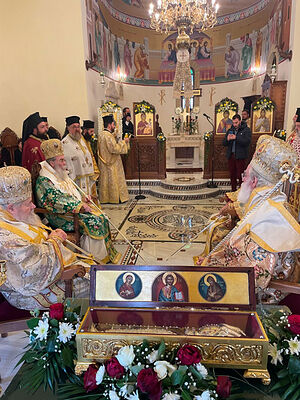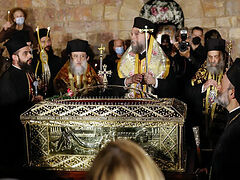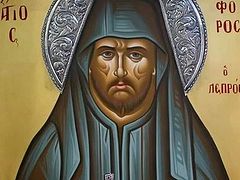Sirikari, Crete, Greece, January 5, 2023
 Photo: romfea.gr Thousands of pilgrims and several hierarchs of the Greek Orthodox Church came together in Crete over the past two days to celebrate the feast of St. Nikephoros the Leper.
Photo: romfea.gr Thousands of pilgrims and several hierarchs of the Greek Orthodox Church came together in Crete over the past two days to celebrate the feast of St. Nikephoros the Leper.
The celebration was held in the great saint’s birthplace in the village of Sirikari, where a pilgrimage church in honor of St. Nikephoros was opened in 2018 and consecrated in September 2022, reports Romfea.
St. Nikephoros was a 20th-century monk who lived in the leper colony of Chios. He was a disciple of St. Anthimos of Chios.
The veneration of the saint increased during the COVID pandemic, as parishes and monasteries throughout the Orthodox world turned to him for his prayerful intercessions. It was reported that he appeared to a man in Bulgaria and revealed to him the cure for the coronavirus.
The Vespers for the feast was celebrated by Metropolitan Andreas of Arkalochori, who spoke about how St. Nikephoros’ example teaches us to seek beyond the human word to find the Divine Word.
“We all seek the Divine Word. We seek the invisible redemption and strive from earth to commune with Heaven… We’re here for spiritual reasons and we receive spiritual strength,” the hierarch preached.
Orthros for the feast was presided over by Metropolitan Damaskinos of Kydonia, and the Liturgy by the aforementioned Met. Andreas. The homily was offered by Metropolitan Prodromos of Rethymno, focusing on the great cross of leprosy that St. Nikephoros bore for many years.
“Within his flesh, disfigured and humiliated by leprosy, hid the great treasure of a great heart… an embrace that opened to accommodate the whole world, so that this patient, overworked, and despised man could become a cause of joy, strength, and consolation for the whole world,” Met. Prodromos said.
Metropolitan Amphilochios of Kissamos greeted and thanked his fellow hierarchs for their prayers and welcomed the crowds of pilgrims from all over Crete, Greece, and beyond.
“The heart of St. Nikephoros beats in this place,” Met. Amphilochios emphasized.
***
The Life of St. Nikephoros the Leper from the site of the Orthodox Church in America:
Father Nikephoros (Nicholas Tzanakakis in the world) was born in 1890 in a mountainous village in Khania, in Sikari, Kastanohori to the west of the prefecture with a healthy climate, with beautiful forests, rich waters, gorges and caves. This village has a peculiarity that we do not often encounter: it is divided into eleven neighborhoods, which have also been named after the families who first settled there. So Saint Nikephoros was born in the neighborhood of Kostoyianides.
His parents were simple and pious villagers, who died when he was still a young child, leaving him as an orphan. So, at the age of thirteen, he left his home. His grandfather, who had undertaken to raise him, went to Khania to work there in a barber shop in order to learn the job. Then he showed the first signs of Hansen’s disease, i.e. leprosy. The lepers were isolated on the island of Spinalonga because leprosy was a contagious disease and it was treated with fear and dismay.
Nicholas was sixteen years old when signs of the disease began to become more conspicuous, so he left on a boat to Egypt in order to avoid being confined to Spinalonga. He remained in Alexandria, working in a barber shop again, but the signs of the disease became more and more apparent, especially on his hands and face. That is why, through the intervention of a cleric, he went to Chios, where there was a church for lepers at that time, and the priest was Father Anthimos Vagianos, later Saint Anthimos (February 15).
Nicholas arrived in Chios in 1914 at the age of twenty-four. In the leper hospital of Chios, which was a complex with many homesteads, there was a chapel of Saint Lazarus, where the wonderworking icon of Panagia Ypakoe (Feb. 2) was kept. In this space, the course of virtues was opened for Nicholas. Within two years Saint Anthimos considered him ready for the angelic Schema and tonsured him with the name Nikephoros. The disease progressed and evolved in the absence of suitable drugs, causing many large lesions (a drug was found in 1947).
Father Nikephoros lived with unquestioning, genuine obedience to his Spiritual Father, and with austere fasting, working in the gardens. He also recorded the miracles of Saint Anthimos, which he had witnessed with his own eyes (many of these were related to the deliverance of those possessed by demons).
There was a special spiritual relationship between Saint Anthimos and the monk Nikephoros, who always remained close to him, as Father Theoklitos Dionysiatis writes in his book Saint Anthimos of Chios. Father Nikephoros prayed at night for hours on end making countless metanias, he did not quarrel with anyone, nor injure anyone's heart, and he was the master chanter of the temple. Because of his illness, however, he slowly lost his sight, and so he chanted the troparia and the Epistles from memory.
The Chios leprosarium was closed in 1957 and the remaining patients, together with Father Nikephoros, were sent to Saint Barbara’s home for lepers in Athens, in Aigaleo. At that time, Father Nikephoros was about 67 years old. His members and his eyes were completely altered and distorted by the disease.
There, Father Eumenios also lived there at the home for lepers. He also suffered from Hansen’s disease, but with the medication he received, he was completely cured. However, he decided to remain in the home for lepers for the rest of his life near his fellow sufferers, caring for them with much love. Thus he submitted to Father Nikephoros, to whom the Lord had given many gifts as a reward for his patience. A crowd of people gathered in the humble cell of the leper Nikephoros, in Saint Barbara in Aigaleo to obtain his prayers. Here are some testimonies of those who met him:
“While he was prostrate with wounds and pains, he did not complain, but he showed great patience.”
“He had the charisma of consoling those who were sad. His eyes were permanently irritated, and he had limited sight. He also had stiffness in his hands and paralysis in his lower limbs. Nonetheless, he endured all of this in the sweetest, meek, smiling, delightful way, and he was also pleasant and lovable.”
“His face, which was eaten away by the marks of his illness, and his wounds, shone. It was a joy for those who saw this destitute and seemingly feeble man saying, May His holy name be glorified.”
Father Nikephoros reposed on January 4, 1964 at the age of 74. After three years, his holy relics were exhumed and found to be fragrant. Father Eumenios and other believers reported many cases where miracles occurred by calling on Saint Nikephoros to intercede with God.
The life of Saint Nikephoros was a brilliant example and model for everyone. He was pleasing to God because he had endured so much. For this reason, we have many testimonies that our saint received from the Holy Spirit the gift of discernment as and a host of other charisms. We should note that most of the miracles are recorded, and today the saint gives generous help to anyone in need. Surely there will be many more miracles which not have not yet been made manifest.
Follow OrthoChristian on Twitter, Vkontakte, Telegram, WhatsApp, MeWe, and Gab!




